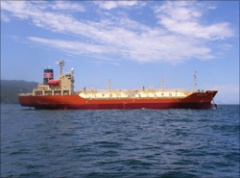Difference between revisions of "Propylene"
(→Shipment / Storage / Risk factors) |
(→Shipment / Storage / Risk factors) |
||
| Line 41: | Line 41: | ||
<br> | <br> | ||
For overseas carriage aspects of [[Chemicals]], the readers are recommended to acquire or have access to a good chemical dictionary, and a copy of the International Maritime Dangerous Goods (IMDG) Code, issued by the International Maritime Organisation. Also consult the applicable MSDS sheet.<br><br> | For overseas carriage aspects of [[Chemicals]], the readers are recommended to acquire or have access to a good chemical dictionary, and a copy of the International Maritime Dangerous Goods (IMDG) Code, issued by the International Maritime Organisation. Also consult the applicable MSDS sheet.<br><br> | ||
| − | See also: http://www.liquefiedgascarrier.com | + | See also: http://www.liquefiedgascarrier.com<br><br> |
| + | [[Category: Products]][[Category: Oil and chemicals]] | ||
Revision as of 14:05, 2 April 2014
| Infobox on Propylene | |
|---|---|
| Example of Propylene |  |
| Facts | |
| Origin | - |
| Stowage factor (in m3/t) | - |
| Humidity / moisture | - |
| Ventilation | - |
| Risk factors | See text |
Propylene
Description
Propylene is a co-product of the ethylene production in the steam cracking of naphtha. Propylene is the second member of the olefine family and is currently a high growth chemical because of the high demand for polypropylene, a principal derivative. Crude propylene is also obtained from oil refinery gases in a state which needs purifying for chemical production.
Propylene is a colourless gas, soluble in alcohol and ether, slightly soluble in water.
In Europe propylene was always produced as a co-product of ethylene, independent of demand. As a result there was always an over-capacity and propylene prices remained low. Attempts were made to make high severity crackers with high ethylene/propylene ratios; however, technological problems made such as crackers unfeasible. In the interim, demand for propylene has grown until now it enjoys higher growth rates than ethylene. There are two main reasons for this change in the fortunes of propylene:
1) Demand for polypropylene is high and new capacity authorizations are going ahead. It is the most versatile and lowest cost elfin-bases polymer for the manufacture of a variety of synthetics.
2) An improved catalyst is available for acrylonitrile production which will allow greatly increased production of this commodity at existing plants for low capital expenditure.
Since propylene is dependent on ethylene production, if ethylene forecasts are over-optimistic, propylene production could be hit. However, crude propylene is also obtainable from oil refinery operations and can be used as a chemical feedstock after purification. Furthermore, doubts on the future availability of light naphtha are resulting in the planning and construction of new, more flexible ethylene crackers to run on heavier fractions which gives increased potential for propylene production.
Nearly a quarter of the propylene produced in West Europe is used for the manufacture of polypropylene, 18% being used for acrylonitrile, 11% propylene oxide and 10% cumene.
Application
Essentially all of the propylene produced for chemical purposes is consumed as a chemical intermediate in other chemical manufacturing processes. Commercial propylene is used to produce polypropylene, acrylonitrile, oxo chemicals, propylene oxide, cumene, isopropyl alcohol, acrylic acid and other chemicals which enable the manufacture of many chemicals and plastics.
Use: Manufacture of isopropyl alcohol, polypropylene, synthetic glycerol, acrylonitrile, propylene oxide, heptene, cumene, polymer gasoline, acrylic acid, vinyl resins, oxo chemicals.
Shipment / Storage / Risk factors
Highly flammable, dangerous fire risk, explosive limits in air 2-11%. An asphyxiant gas.
Propylene is a flammable material and should be handled only with adequate ventilation and in areas where ignition sources have been removed (e.g., matches and unprotected light switches). The lower flammability level for propylene is about 20,000 ppm (2.0 volume percent in air). If flammability levels are reached, evacuate the area and call emergency response personnel.
| Boiling point | -47,7°C. |
| Freezing point | 185,2°C. |
| Flash point | -108° |
| Autoignition temp. | 497°C |
For overseas carriage aspects of Chemicals, the readers are recommended to acquire or have access to a good chemical dictionary, and a copy of the International Maritime Dangerous Goods (IMDG) Code, issued by the International Maritime Organisation. Also consult the applicable MSDS sheet.
See also: http://www.liquefiedgascarrier.com











